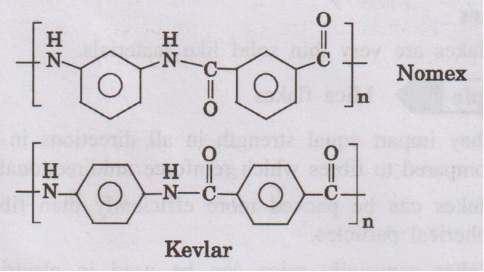Engineering Chemistry: Unit III: b. Composites
Constituents of Composites
Composites consist of two important constituents. (i) Matrix phase (or) Matrix resin (ii) Dispersed phase (or) Reinforcement.
CONSTITUENTS OF COMPOSITES
Composites consist of two important constituents.
(i) Matrix phase (or) Matrix resin
(ii) Dispersed phase (or) Reinforcement.
1. Matrix Phase (or) Matrix resin
Matrix phase is the continuous body constituent, which encloses
the composite. Matrix phase may be metals, ceramics (or) polymers (liquid
resins), composites using these matrix are known as
(i) Metal Matrix Composites (MMC)
(ii) Ceramic Matrix Composites (CMC)
(iii) Polymer Matrix Composites (PMC) respectively.
Liquid Resins
Polymers used as adhesives, potting compounds, sealants, etc., in
a liquid form are called as liquid resins.
Examples : Epoxy adhesives,
polysulphides are typical commercially available adhesives.
Cure reactions
Formation of cross-linking in certain polymers is known as cure
reaction.
Cure reactions are done by using a curing agent. These
uncross-linked linear polymers contain functional groups (or) double bonds.
They are usually not high molecular weight resin and are in the form of liquid
resins. They are also called as "pre-polymers”. The liquid resins will be
cured in the moulding to get solid mass of cross linked products.
2. Dispersed Phase (or) Reinforcement
Dispersed phase is the structural constituent, which determines
the internal structure of composite.
Examples : Fibres, Particulates, Flakes, Whiskers.
Reinforcement
It is a process of improving the characteristics of the plastic
matrix by adding reinforcing agents. The reinforcing agents may be organic (or)
inorganic in nature. They may be in the form of powder, flakes, fibres. These
materials are characterised by high strength to weight ratio, excellent
resistance to erosion, corrosion, etc., and ease of fabrication. For effective
structural performance, there should be a strong adhesive bond between the
matrix phase (or) matrix resin and the dispersed phase (or) reinforcing agents.
1. Fibres
Fibres are long and thin filament of any macromolecular substance
such as polymer, metal (or) ceramic having high length to diameter ratio at
least 100:1.
The fibre (reinforcement material) can be used in variety of forms
like continuous rovings, cloth, chopped strands, etc.,
Characteristics of Fibre
(i) Fibre possesses high tensile strength.
(ii) It possesses high stiffness.
(iii) It lowers overall density of composites.
Classification of Fibres
The fibres used in reinforcements are classified as
(i) Natural fibres: These are
derived from naturally available sources.
Examples : Cotton, wool, silk,
sisal, jute and coir.
(ii) Semi-synthetic fibres:
These are produced by modifying the naturally occurring materials.
Examples : Rayon, cellulosic.
(iii) Synthetic fibres: These are
produced exclusively by the laboratory processes.
Examples : Polyester fibre,
polypropylene and carbon fibre (poly acrylonitrile), glass fibres, aramid
fibres.
(iv) Aramid fibres: These are
aromatic polyamides.
Example : Kevlar.
(i) Important Natural Fibres
(a) Cotton Fibres: Cotton is
a vegetable fibre and is made of cellulose molecule, which is a linear polymer
of B-glucose. Cotton fibres provide a low cost fibrous reinforcements for the
use in dough moulding compounds (DMC). Mostly phenolic resin based moulding
compounds.
The painted fabrics can be used to provide a decorative finish for
applications like wall panels.
(b) Wool Fibre: Wool is an
animal protein fibre. Like other proteins, wool is also made up of
a-aminoacids. These aminoacids are joined end-to-end in the form of peptide
chains forming long chain molecules. Many of the physical and chemical
properties of wool are due to the disulphide bonds formed by the covalent cross-linking
of the cystein molecule. Any chemical that affect the disulphide bonds may
cause structural break down of the fibre. The elastic properties of the wool
fibre is due to the presence of hydrogen bond between various peptide chain.
(c) Silk: Silk is a natural
protein fibre produced by the insect, silk worm. It possesses all the desirable
qualities of fibre such as softness, strength, elongation, etc. It has a bright
lusture and it is an excellent insulator of heat, hence it is warm in winter and
cool in summer.
(d) Sisal: Sisal is another
low-cost fibrous material, which is also used in phenolic based dough moulding
compounds.
(e) Jute and Coir: They are
also low-cost fibrous material for reinforcement for polyester resin. They can
be used as woven cloth (or) in yarn form for filament winding. A variety of
objects like houses, fishing boats have been developed.
(ii) Synthetic Fibres
(a) Polyethylene terephthalate (PET) (or) Terylene (or) Dacron
PET is produced by the condensation of ethylene glycol (EG) and
terephthalic acid (TPA). This fibre is used as surface tissues which can be
used to provide improved chemical and abrasion resistance. They may be used in
light weight woven fabrics. They are rarely used as the main reinforcement,
although they give laminates with high impact resistance, excellent chemical
and abrasion resistance. Generally they are used in combination with glass
fibres.
(b) Poly Propylene: It is
obtained by polymerisation of propylene. These fibres possess better hardness,
strength, stiffness. These fibres are used in making ropes, carpets, blankets,
hand bags, apparels, etc.
(c) Carbon fibres: Carbon
fibres are obtained as a continuous filament by the pyrolysis of organic fibres
in an inert atmosphere such as cellulose, polyacrylonitrile (PAN)
Properties
The carbon fibres are widely used because of their specific
strength, stiffness, high modules even at elevated temperatures. Also they are
resistant to moisture, acids, bases and a number of solvents.
PAN

Uses
PAN fibre is used to make surfacing tissues to provide improved
chemical resistance. Tissues may be used in conventional constructions (or)
light weight woven fabrics.
(d) Nylon

Nylon fabrics are used as reinforcements for epoxide resin systems
to give flexible laminates with high impact, abrasion and chemical resistance.
They are sometimes combined with glass fibre reinforcements for specialized
applications.
(iii) Aramid Fibres
The wholly aromatic polyamides are called as aramids. They are
made by spinning liquid crystal aramid oligomers (Kevlar).
The meta-linked poly-m-phenylene isophthalimide is called Nomex,
where as para-linked poly-p-phenylene phthalimide is called Kevlar.

Properties
These are used as high performance fibers because of their high
modules, tensile strength, stability at high temperatures, wide temperature
range (- 200 to 200°C) for retaining mechanical properties, excellent toughness
and impact resistance.
Uses
Aramid fibres are used in reinforcements, widely used in tyre card
reinforcement, bullet proof clothing, race drivers, astronaut suits, etc.,
2. Particulates
Particulates are small pieces of hard solid materials. They may be
metallic (or) non-metallic. Generally distribution of particles in a given
matrix is random, so the resulting composites are usually isotropic. Due to the
inherent hardness, the particles in a composite cause constraints on the
plastic deformation on the matrix.
Effect of particulate in particulate composite
(i) Surface hardness gets increased.
(ii) Wear and abrasion resistance are increased.
(iii) Performance at elevated temperature is improved.
(iv) Shrinkage and friction is reduced.
(v) Electrical and thermal conductivities are modified.
3. Flakes
Flakes are very thin solid like materials.
Example : Mica flakes
(i) They impart equal strength in all directions in a plane compared
to fibres which reinforce unidirectionally only.
(ii) Flakes can be packed more efficiently than fibres (or) spherical
particles.
(iii) Flakes especially mica can be used in electrical and thermal
insulating appliances.
4. Whiskers
Whiskers are thin strong fibre like material made by growing a
crystal.
Examples : Graphite, silicon
carbide, silicon nitride
(i) Perfect whiskers possess much higher strength than in bulk,
but irregularities decreases their strength.
(ii) They possess high elastic modulus and high degree of crystallinity.
(iii) They possess exceptionally high strength.
(iv) As it is costly and difficult to incorporate in matrix they find
limited use in composite.
Engineering Chemistry: Unit III: b. Composites : Tag: Engineering Chemistry : - Constituents of Composites
Related Topics
Related Subjects
Engineering Chemistry
CY3151 1st Semester | 2021 Regulation | 1st Semester Common to all Dept 2021 Regulation
